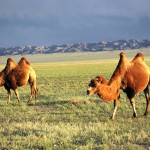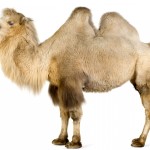The Bactrian camel is a type of rare camel. Its biological name is Camelus bactrianus. The Bactrian camel is native to regions in central Asia. This kind of camel was popular with kings because of their ability to tread many miles without food and water. They can withstand any sort of weather, drought, and heights.
The Bactrian camel was discovered in the 19th century. It was found by Nikolai Przhevalsky. The Bactrian camel got its name from the place Bactria. Though the originate of the name are still being disputed today, they were found mainly in central Asia and Iran. The Bactrian camel can be mostly found in parts of the Gobi Desert.
Appearance :
The Bactrian camel is an even-toed and large animal. It comes with two humps unlike the traditional camel that comes with a single hump, hence the name the Bactrian camel. Today, the population of the Bactrian camel is less than two million. The Bactrian camel can grow up to 7 feet in height.
There are some Bactrian camels that are taller than 7 feet. The length of the Bactrian camel can be less than 10 feet in length. Males are generally larger than females. Their coat comes in different shades, though the most common shade is a brown color. On the throat and neck a long mane can be found.
The hairs stand more than 9 inches in length. The humps consist of fat and not water. This helps them during tough conditions and they can go without food and water for long durations. The face of the Bactrian camel is triangular and long. They have nostrils that can be sealed. This helps them during sand storms.
Since their feet are tough, they are able to walk in strict conditions.
Diet :
The Bactrian camel lives on water and plants. Like camels, the Bactrian camel has the ability to store water for long periods of time. They are considered to be popular among many households in central Asia even today. That is because they withstand high temperature. It can be either very cold or very hot.
You would be astounded to know that they can drink more than 50 liters of water at a time. When they have sufficient food and water to eat, their humps are erect. As the food resources reduce, they lean on to a side. They can run up to speeds of more than 60 km/h. Since they are excellent swimmers they can be taken across water bodies too.
They have a strong nose which can find out smells from a distance. They sleep at night and find food at day. They are herbivorous animals and consume prickly and dry vegetation. When they are not able to find their main source of food, they consume bones, carcasses, and skin. Sometimes, they can also live in sandals, ropes, and tents.
It is amazing at how this animal and eats such food and survives. It is not often that you hear about an animal that eats on such food and survives. The Bactrian camel is an ideal animal to keep when you are living in the desert. When compared to the traditional camels, they are far better and economical. You would want to consider using them.
Breeding :
The Bactrian camel breed after the mating seasons. The males being larger than the females choose their partners before mating. They live in groups that mostly contain 5 to 20 Bactrian camels. The leader is usually a male Bactrian camel. A new born Bactrian camel can weigh up to 36 kg.
Predators :
The main predator of the Bactrian camel is human beings. They are often hunted for their meat, which is considered a delicacy in many desert regions. Other predators of the Bactrian camel are gray wolves and the Caspian tiger. However, the Caspian tiger is extinct. The attacks on the Bactrian camel of gray wolves are increasing each year.
When they feel threatened, they tend to spit or kick their legs.
Life Cycles & Lifestyle :
The Bactrian camel has lived for 50 years. The Chinese Tang dynasty (618–907) has been described by artwork of the Bactrian camel.
Also read: Camel - The Ship Of The Desert
Facts :
The main difference between the traditional camel and the Bactrian camel is that they can drink salt water. You would find that camels which are domesticated cannot drink salty water. But, it is not very clear how the Bactrian camel can drink in salt water. As of October 2002, their population was 800 only. They are on the International Union for Conservation of Nature (IUCN) Red List of Threatened Species.
During the winter season they can be found migrating from Siberia. You would be interested to find out the two humps located on both sides of the Bactrian camel get soft as the fat decreases. The Bactrian camel doesn’t sweat, which helps them store fluids inside them for longer time. You would be surprised to know that the Bactrian camel can weigh more than 810 kg.
For more than 6,000 years, the Bactrian camel has been used for transportation.
Habitat :
The Bactrian camels are migratory. They can survive in deserts, mountains, sand dunes, and plains. They are usually found in these areas because water and food can be found here. During the winter months, snow forms. As it becomes hotter, the snow becomes water and the Bactrian camel drinks that to survive.
Pictures, Images, Pics and Photos of Bactrian Camel :
According to the Evolutionarily Distinct and Globally Endangered (EDGE) project, the Bactrian camel has been identified as an endangered species. The Evolutionarily Distinct and Globally Endangered (EDGE) program focuses on conserving species that are both highly unique and at risk of extinction. Like mentioned before, there are only less than 700 Bactrian camel left in the world.
Their rates have been reduced with each passing year that is because the land has been taken up for industrial and mining complexes. They are forced to survive with less water and food.















